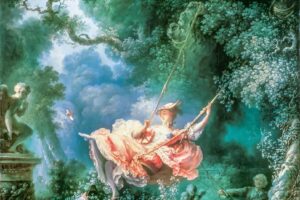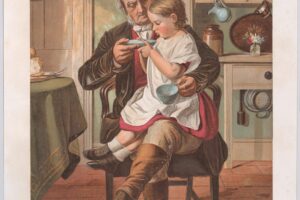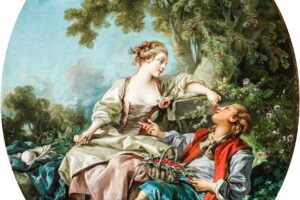Napoleon Crossing the Alps
Jacques Louis David, 1800
A Hero in the Saddle
At the heart of this powerful painting stands a man on a rearing white horse—cloak flying, finger raised, eyes locked forward. He is Napoleon Bonaparte, and this moment captures more than a general on a mountain path. It is the very image of willpower, ambition, and destiny wrapped in one sweeping gesture. Jacques-Louis David paints not what the scene truly looked like—but what it meant.
Not a Portrait, But a Legend
In May of 1800, Napoleon led his army across the Alps through the Great St. Bernard Pass, surprising Austrian forces in Italy. In reality, he crossed calmly on a mule. But David had no interest in mules. He painted a leader as the world saw him—or as he wanted to be seen—majestic, unstoppable, chosen by fate.
The Wind, the Horse, the Flame
The sky churns behind him. The wind whips his golden cloak like a flag of fire. His steed, wild-eyed and muscular, climbs the rocks with impossible power. Even the mane of the horse seems to follow Napoleon’s direction, as if every thread of nature bends to his command. On the rocks below, carved in stone, are the names: Bonaparte, Hannibal, Charlemagne—three commanders who dared the Alps before him. But here, Napoleon is first among them.
The Power of Pose
With his left hand, Napoleon reins in the storm. With his right, he points ahead—not to a single place, but to the future itself. His face is calm, pale, almost detached. He doesn’t struggle. He leads. Every detail—the tight gloves, the gold-trimmed uniform, the tricolor sash—glows with precision. David, the master of Neoclassical painting, uses smooth lines and sharp contrasts to turn myth into form.
More Than a Battle
This is not just about war. It’s about momentum. The kind that shapes nations. The kind that cannot be held back by weather, terrain, or doubt. Napoleon is not shown as a man in battle—but as a man above it. And that’s exactly what he wanted the world to believe.
The Painting That Spoke Louder Than Cannons
Commissioned by the King of Spain, this painting would go on to define Napoleon’s image for generations. It has been copied, admired, debated, and parodied—but never forgotten. In Napoleon Crossing the Alps, David did not just paint a military crossing—he painted the crossing into legend.
About Artist

Jacques-Louis David (1748–1825) was a French painter who became the leading figure of Neoclassicism, a movement that rejected the frivolity of the Rococo and sought to revive the moral and aesthetic values of ancient Greece and Rome. His art was not just beautiful; it was a powerful tool for political and social change. David’s work defined a new style that was severe, intellectual, and deeply political, making him a central figure in the French Revolution and later, the court of Napoleon Bonaparte.
Artistic Style and Legacy
David’s style is characterized by a dramatic shift from the soft, sensual curves of Rococo to the sharp lines and moral clarity of Neoclassicism. His paintings are known for:
- Classical Themes and Heroes: He drew heavily from ancient history and mythology to tell stories of virtue, civic duty, and self-sacrifice.
- Sharp, Defined Lines: He rejected the loose brushwork of the Rococo in favor of crisp, sculptural forms that give his figures a sense of heroic grandeur.
- Moral and Political Messages: His art often served as propaganda, urging viewers to embrace patriotism and civic virtue.
- Controlled Lighting: He used strong, raking light to emphasize form and clarity, avoiding the dramatic tenebrism of the Baroque.
Artwork Profile
Here paintings represent the full range of his career, from his early Neoclassical masterpieces to his later works for Napoleon.
- Belisarius Begging for Alms (1781): An early Neoclassical work that depicts the Roman general Belisarius, unjustly fallen into disgrace, begging for money. It’s a clear moral statement about the cruelty of the state.
- The Lictors Bring to Brutus the Bodies of His Sons (1789): A powerful and stark depiction of a Roman leader who chose civic duty over personal love. This painting, with its clear composition and somber tone, was seen as a call for revolutionary sacrifice.
- The Farewell of Telemachus and Eucharis (1782): A more sentimental and intimate work from his early career, it depicts a scene from a classical novel, showing his softer side before his full turn to political subjects.
- The Death of Socrates (1787): One of his most famous masterpieces. It portrays the Greek philosopher Socrates as a moral hero calmly facing death. The painting’s noble composition and stoic emotion made it an icon of Enlightenment ideals.
- The Anger of Achilles (1819): This late painting, from his exile in Brussels, shows David returning to classical subjects with a more refined and emotionally charged style.
- Oath of the Horatii (1784): Arguably his most famous work and a manifesto of Neoclassicism. It depicts three Roman brothers swearing an oath to their father, prioritizing duty to Rome over family. Its stark, geometric composition and powerful moral theme made it an instant sensation.
- Napoleon Crossing the Alps (1801): A famous equestrian portrait of Napoleon as a heroic figure. The painting is a work of political propaganda, portraying Napoleon as a dynamic and determined leader.
- The Emperor Napoleon in His Study at the Tuileries (1812): A more intimate portrait of Napoleon, but one that still emphasizes his power and intellectual prowess. It shows the emperor standing in his study late at night, a subtle nod to his tireless work ethic.



